Evaluation of Weakening Characteristics of Reinforced Concrete Using High-Frequency Induction Heating Method
Abstract
:1. Introduction
2. Deconstruction Model of Reinforced Concrete Using High-Frequency Induction Heating
2.1. Reinforcing Bar Characteristics at High Temperatures
2.1.1. Density and Specific Heat
2.1.2. Thermal Conductivity
2.2. Characteristics of Concrete at High Temperature
2.2.1. Thermal Conductivity of Concrete
2.2.2. Vulnerability Characteristics of Concrete at High Temperatures
3. Experimental Considerations
3.1. Vulnerability of Single Reinforced Concrete to High-Frequency Induction Heating
3.1.1. Experimental Factors and Levels
3.1.2. Manufacturing and Testing Methods of Induction-Heating Specimens
3.2. Experimental Results and Considerations
3.2.1. Temperature Characteristics of Single Reinforced Concrete by High-Frequency Induction Heating
- (1)
- Compression Strength by Preparation
- (2)
- Increasing Temperature Characteristics
3.2.2. Physical and Mechanical Properties of Single Reinforced Concrete by High-Frequency Induction Heating
- (1)
- Cracks in Reinforced Concrete
- (a)
- Experiment Summary
- (b)
- Experimental Results and Considerations
- (2)
- Temperature-Induced Vulnerability
- (a)
- Vulnerability due to Changes in Void Volume
- (b)
- Chemical Vulnerability Characteristics
4. Experimental Method
4.1. Simultaneous Thermal Weight/Differential Thermal Analysis (TG-DTA)
4.2. Experimental Results and Considerations
4.3. Remaining Strength of Reinforcement
- (a)
- Experiment overview
- (b)
- Adhesion mechanism of deformed reinforcing bars
- ①
- Shear stress due to chemical adhesive force between the concrete and reinforced steel surface:
- ②
- Support stress due to dowel action on the rib surface of reinforcing steel: fb
- ③
- Shear stress generated in the concrete between adjacent ribs: vc
- ④
- Acts as the main element above ②.
- (c)
- Experimental methods and calculations
4.4. Prerequisite
5. Calculations and Evaluation
- (d)
- Experimental results and considerations
5.1. Evaluation of Rebar Recovery Rate after High-Frequency Induction Heating
- (1)
- Experimental Methods
- (2)
- Results and considerations
5.2. Fragility of Cross Reinforced Concrete Using High Frequency Induction Heating Method
5.2.1. Experimental Factors and Levels
5.2.2. Manufacturing and Testing Methods of Induction Heating Specimens
5.2.3. Experimental Results
- (1)
- Temperature Rise Characteristics of Cross-Reinforced Concrete Subjected to High-Frequency Induction Heating
- (2)
- Crack Characteristics of Cross-Reinforced Concrete due to High-Frequency Induction Heating
6. Conclusions
- (1)
- For a single reinforced concrete, the temperature difference between concrete and non-range concrete within the induction heating range is large. This is the result of heating the reinforcing steel in the air using a high-frequency induction heating method.
- (2)
- When performing high-frequency induction heating of air-dry and absolute-dry single reinforced concrete, a more significant temperature increase was seen in dry conditions. This is more clearly exhibited by the reinforcing bars with D19 and D25, which have a higher heating efficiency.
- (3)
- The maximum output of a test specimen with a single reinforcement showed a sharp decrease in heating efficiency at a heating distance of 50 mm, while the maximum output at 10 kW showed excellent heating efficiency at a heating distance of 50 mm. However, when the heating distance was short, there was no significant difference in the temperature trend.
- (4)
- In single reinforced concrete specimens, cracks occurred in the direction perpendicular to the reinforcing bar in most specimens. However, over a short distance, cracks occurred in both directions. In addition, when the cross-sectional area of the reinforcing steel was reduced, the range of cracks increased owing to the increase in thermal conduction efficiency, but the width of cracks decreased owing to the decrease in the expansion pressure. In contrast, when full heating was carried out, the cracks were generated continuously even if the length and circumference of the reinforcement were followed. It was found that cracks had a significant effect on the reduction of the confinement stress of concrete.
- (5)
- In the case of high-frequency induction heating, there was no large difference in the air gap volume due to the water–binder ratio, but it was determined that dehydration of the gel and capillary water occurred, and calcium hydroxide was decomposed and evaporated, resulting in a significant increase in the air gap volume. This was confirmed both from the results of TGDTA and the measurement of changes in heat absorption intervals due to the decomposition of calcium hydroxide. Accordingly, when high-frequency induction heating was performed, it was determined that heat of approximately 500–600 °C is conducted on the concrete attached to the surface of the reinforcing steel.
- (6)
- Local induction heating was found to increase with the diameter of the reinforcing bar and decrease with the thermal conductivity. Moreover, it was proportional to the area of the bar. However, owing to the increased heat loss due to heat transfer, the size and range of the reinforcing bar ribs were proportionally reduced. In addition, if cracks occur owing to the expansion pressure of the reinforcing steel, they are mostly localized in the reinforcing steel ribs, and as they progress to the concrete surface, the stress is reduced eventually resulting in the reduction of the adhesion strength.
- (7)
- If the reinforcing bars have the same diameter and heating distance, the higher the water–binder ratio, the larger the range of evaporation of free water due to induction heating, and the greater the range of air gaps around the reinforcing bars.
- (8)
- Finally, for the crossed reinforcing bars, it was found that the heating range of the intersection was higher than that of heating between the reinforcing bars, where the heating range was smaller. Heating between reinforcing bars produced more cracks than heating at an intersection of the reinforcing bars, which is close to the heating distance, as determined by the fact that the heating range is wider on the final separation side, but the temperature rise characteristics are reduced.
Author Contributions
Funding
Institutional Review Board Statement
Informed Consent Statement
Data Availability Statement
Conflicts of Interest
References
- Neville, A. Chloride attack of reinforced concrete: An overview. Mater. Struct. 1995, 28, 63–70. [Google Scholar] [CrossRef]
- Washer, G.A. Developments for the non-destructive evaluation of highway bridges in the USA. NDT E Int. 1998, 31, 245–249. [Google Scholar] [CrossRef]
- Jang, B.S.; Oh, B.H. Effects of non-uniform corrosion on the cracking and service life of reinforced concrete structures. Cem. Concr. Res. 2010, 40, 1441–1450. [Google Scholar] [CrossRef]
- Shah, A.A.; Ribakov, Y. Non-destructive measurements of crack assessment and defect detection in concrete structures. Mater. Des. 2008, 29, 61–69. [Google Scholar] [CrossRef]
- Poursaee, A.; Hansson, C.M. Potential pitfalls in assessing chloride-induced corrosion of steel in concrete. Cem. Concr. Res. 2009, 39, 391–400. [Google Scholar] [CrossRef]
- Legat, A.; Leban, M.; Bajt, Z. Corrosion processes of steel in concrete characterized by means of electrochemical noise. Electrochim. Acta 2004, 49, 2741–2751. [Google Scholar] [CrossRef]
- McCann, D.M.; Forde, M.C. Review of NDT methods in the assessment of concrete and masonry structures. NDT E Int. 2001, 34, 71–84. [Google Scholar] [CrossRef]
- Pradhan, B.; Bhattacharjee, B. Performance evaluation of rebar in chloride contaminated concrete by corrosion rate. Constr. Build. Mater. 2009, 23, 2346–2356. [Google Scholar] [CrossRef]
- Parthiban, T.; Ravi, R.; Parthiban, G.T. Potential monitoring system for corrosion of steel in concrete. Adv. Eng. Softw. 2006, 37, 375–381. [Google Scholar] [CrossRef]
- Pour-Ghaz, M.; Isgor, O.B.; Ghods, P. Quantitative interpretation of half-cell potential measurements in concrete 8 Advances in Civil Engineering structures. J. Mater. Civ. Eng. 2014, 21, 467–475. [Google Scholar] [CrossRef]
- Hornbostel, K.; Larsen, K.; Geiker, M.R. Relationship between concrete resistivity and corrosion rate—A literature review. Cem. Concr. Comp. 2013, 39, 60–72. [Google Scholar] [CrossRef]
- Takahashi, Y.; Matsubara, E.; Suzuki, S.; Okamoto, Y.; Komatsu, T.; Konishi, H.; Mizuki, J.; Waseda, Y. In-situ x-ray diffraction of corrosion products formed on iron surfaces. Mater Trans. 2005, 46, 637–662. [Google Scholar] [CrossRef] [Green Version]
- Yeih, W.; Huang, R. Detection of the corrosion damage in reinforced concrete members by ultrasonic testing. Cem. Concr. Res. 1998, 28, 1071–1083. [Google Scholar] [CrossRef]
- Ahmed, R.; Rifat, A.A.; Yetisen, A.K.; Salem, M.S.; Yun, S.-H.; Butt, H. Optical microring resonator based corrosion sensing. RSC Adv. 2016, 6, 56127–56133. [Google Scholar] [CrossRef]
- Vrana, J.; Goldammer, M.; Bailey, K. Induction and conduction thermography: Optimizing the electromagnetic excitation towards application. Rev. Prog. Quant. Nondestruct. Eval. 2009, 28, 518–525. [Google Scholar]
- Zhang, H.; Liao, L.; Zhao, R.; Zhou, J.; Yang, M.; Zhao, Y. A new judging criterion for corrosion testing of reinforced concrete based on self-magnetic flux leakage. Int. J. Appl. Electromagn. Mech. 2017, 54, 123–130. [Google Scholar] [CrossRef]
- Gonzalez, J.A.; Cobo, A.; Gonzalez, M.N.; Feliu, S. Onsite determination of corrosion rate in reinforced concrete structures by use of galvanostatic pulses. Corros. Sci. 2001, 43, 611–625. [Google Scholar] [CrossRef]
- Abidin, I.Z.; Gui, Y.T.; Wilson, J. Quantitative evaluation of angular defects by pulsed eddy current thermography. NDT E Int. 2010, 43, 537–546. [Google Scholar] [CrossRef]
- Clark, M.R.; McCann, M.R.; Forde, M.C. Application of infrared thermography to the non-destructive testing of concrete and masonry bridges. NDT E Int. 2003, 36, 265–275. [Google Scholar] [CrossRef]
- Clark, M.; McCann, D.M.; Forde, M.C. Infrared thermographic investigation of railway track ballast. NDT E Int. 2002, 35, 83–94. [Google Scholar] [CrossRef]
- Defer, D.; Shen, J.; Lassue, S.; Duthoit, B. Non-destructive testing of a building wall by studying natural thermal signals. Energy Build. 2002, 34, 63–69. [Google Scholar] [CrossRef]
- Engelbert, P.J.; Hotchkiss, R.H.; Kelly, W.E. Integrated remote sensing and geophysical techniques for locating canal seepage in Nebraska. J. Appl. Geophys. 1997, 38, 143–154. [Google Scholar] [CrossRef]
- Sakagami, T.; Kubo, S. Applications of pulse heating thermography and lock-in thermography to quantitative nondestructive evaluations. Infrared Phys. Technol. 2002, 43, 211–218. [Google Scholar] [CrossRef]
- Baek, S.; Xue, W.; Feng, M.Q.; Kwon, S. Non-destructive corrosion detection in RC through integrated heat induction and IR thermography. J. Nondestruct. Eval. 2012, 31, 181–190. [Google Scholar] [CrossRef]
- Weekes, B.; Almond, D.P.; Cawley, P.; Barden, T. Eddy current induced thermography-probability of detection study of small fatigue cracks in steel, titanium and nickel-based superalloy. NDT E Int. 2012, 49, 47–56. [Google Scholar] [CrossRef]
- He, Y.; Pan, M.; Tian, G.; Chen, D.; Tang, Y.; Zhang, H. Eddy current pulsed phase thermography for subsurface defect quantitatively evaluation. Appl. Phys. Lett. 2013, 103, 144108. [Google Scholar] [CrossRef]
- Liu, L.; Zheng, D.; Zhou, J.T.; He, J.; Xin, J.; Cao, Y. Corrosion detection of bridge reinforced concrete with induction heating and infrared thermography. Int. J. Robot. Autom. 2018, 33, 379–385. [Google Scholar] [CrossRef]
- Landau, L.D.; Lifshitz, E.M.; Pitaevskii, L.P. Electrodynamics of Continuous Media; Pergamon Press: Oxford, UK, 1960. [Google Scholar]
- Aguiar, P.M.; Jacquinot, J.F.; Sakellariou, D. Experimental and numerical examination of eddy (Foucault) currents in rotating micro-coils: Generation of heat and its impact on sample temperature. J. Magn. Reson. 2009, 200, 6–14. [Google Scholar] [CrossRef] [PubMed]
- Cheng, J.; Roy, R.; Agrawal, D. Radically different effects on materials by separated microwave electric and magnetic fields. Mater. Res. Innov. 2002, 5, 170–177. [Google Scholar] [CrossRef]
- Cherradi, A.; Desgardin, G.; Provost, J.; Raveau, B. Electric & Magnetic Field Contributions to the Microwave Sintering of Ceramics Elelctroceramics IV; Wasner, R., Hoffman, S., Bonnenberg, D., Hoffmann, C., Eds.; RWTN: Aachen, Germany, 1994; Volume 2, pp. 1219–1224. [Google Scholar]
- Cao, Z.; Wang, Z.; Yoshikawa, N.; Taniguchi, S. Microwave heating origination and rapid crystallization of PZT thin films in separated H field. J. Phys. D Appl. Phys. 2008, 41, 092003. [Google Scholar] [CrossRef]
- Jin, R.; Chen, Q. Investigation of concrete recycling in the U.S. construction industry. Procedia Eng. 2015, 118, 894–901. [Google Scholar] [CrossRef]
- Chen, C.; Habert, G.; Bouzidi, Y.; Jullien, A. Environmental impact of cement production: Detail of the different processes and cement plant variability evaluation. J. Clean. Prod. 2010, 18, 478–485. [Google Scholar] [CrossRef]
- Rodríguez, G.; Sáez del Bosque, I.F.; Asensio, E.; Sánchez de Rojas, M.I.; Medina, C. Construction and demolition waste applications and maximum daily output in Spanish recycling plants. Waste Manag. Res. 2020, 38, 423–432. [Google Scholar] [CrossRef]
- Li, Y.F. Dielectric Properties and Thermal Properties of Materials during Microwave Heating; Kunming University of Science and Technology: Kunming, China, 2012. [Google Scholar]
- Peng, Z.; Hwang, J.Y.; Park, C.L.; Kim, B.-G.; Onyedika, G. Numerical analysis of heat transfer characteristics in microwave heating of magnetic dielectrics. Metall. Mater. Trans. A 2012, 43, 1070–1078. [Google Scholar] [CrossRef]
- Zhu, J.; Kuznetsov, A.V.; Sandeep, K.P. Mathematical modeling of continuous flow microwave heating of liquids (effects of dielectric properties and design parameters). Int. J. Therm. Sci. 2007, 46, 328–341. [Google Scholar] [CrossRef]
- Catalá-Civera, J.M.; Canós, A.J.; Plaza-González, P.; Gutierrez, J.D.; Garcia-Banos, B.; Penaranda-Foix, F.L. Dynamic measurement of dielectric properties of materials at high temperature during microwave heating in a dual mode cylindrical cavity. IEEE Trans. Microw. Theory Tech. 2015, 63, 2905–2914. [Google Scholar] [CrossRef]
- Szychta, E.; Szychta, L. Comparative analysis of effectiveness of resistance and induction turnout heating. Energies 2020, 13, 5262. [Google Scholar] [CrossRef]
- BSI. Eurocode 2: Design of Concrete Structures-Part 1–2: General Rules-Structural Fire Design; BSI: London, UK, 2004; pp. 26–29. [Google Scholar]
- ASTM C234. Standard Test Method for Comparing Concrete on the Basis of the Bond Developed with Reinforced Steel; ASTM: West Conshohocken, PA, USA, 1991. [Google Scholar]
- Lie, T.T. Fire and Buildings; Applied Science Publishers Ltd.: London, UK, 1972; p. 276. [Google Scholar]
- Lie, T.T. Structural Fire Protection; ASCE Manuals and Reports on Engineering Practice, No. 78; ASCE: New York, NY, USA, 1992; p. 241. [Google Scholar]
- Lie, T.T.; Lin, T.D.; Allen, D.E.; Abrams, M.S. Fire Resistance of Reinforced Concrete Columns; Technical Paper, No. 378; Division of Building Research, National Research Council of Canada: Ottawa, ON, Canada, 1984.
- El-Fitiany, S.F.; Youssef, M.A. Assessing the flexural and axial behaviour of reinforced concrete members at elevated temperatures using sectional analysis. Fire Saf. J. 2009, 44, 691–703. [Google Scholar] [CrossRef]
- Kodur, V.K.R.; Sultan, M.A. Effect of temperature on thermal properties of high-strength concrete. ASCE J. Mater. Civ. Eng. 2003, 15, 101–107. [Google Scholar] [CrossRef]
- Harmathy, T.Z. Fire Safety Design and Concrete; Longman Scientific & Technical: Harlow, UK, 1993. [Google Scholar]
- Schneider, U. Properties of Materials at High Temperatures-Concrete, 2nd ed.; RILEM Report; Gesamthochschule: Kassel, Germany, 1986. [Google Scholar]
- Lim, M.; Choi, H.; Choi, H.; Kitagaki, R.; Noguchi, T. Development of Eco-Friendly Deconstruction Technologies for Recycling Construction Waste. J. Environ. Prot. 2014, 5, 647–661. [Google Scholar] [CrossRef] [Green Version]
- Schneider, U. Behavior of Concrete at High Temperatures; Wilhelm Ernst & Sohn: Berlin, Germany, 1982. [Google Scholar]
- Bažant, Z.P.; Kaplan, M.F.; Bazant, Z.P. Concrete at High Temperatures: Material Properties and Mathematical Models; Prentice Hall: Hoboken, NY, USA, 1996. [Google Scholar]
- Arioz, O. Effect of elevated temperatures on properties of concrete. Fire Saf. J. 2007, 42, 516–522. [Google Scholar] [CrossRef]
- Ichikawa, Y. Prediction of Pore Pressures, Heat and Moisture Transfer Leading to Spalling of Concrete during Fire. Ph.D. Thesis, Imperial College, University of London, London, UK, 2000. [Google Scholar]
- Vedalakshmi, R.; Raj, A.S.; Srinivasan, S.; Babu, K.G. Quantification of hydrated cement products of blended cements in kow and medium strength concrete using TG and DTA technique. Thermochim. Acta 2003, 407, 49–60. [Google Scholar] [CrossRef]
- Choi, E.; Kim, Y.W.; Chung, Y.S.; Yang, K.T. Bond strength of concrete confined by SMA wire jackets. Phys. Procedia 2010, 10, 210–215. [Google Scholar] [CrossRef] [Green Version]
- Rehm, G. Undet Die Grundlagen des Verbundes Zwischen Staglund Beton; Heft 138; Deutscher Ausschuss fur Staglbeton: Berlin, Germany, 1961; p. 59. [Google Scholar]



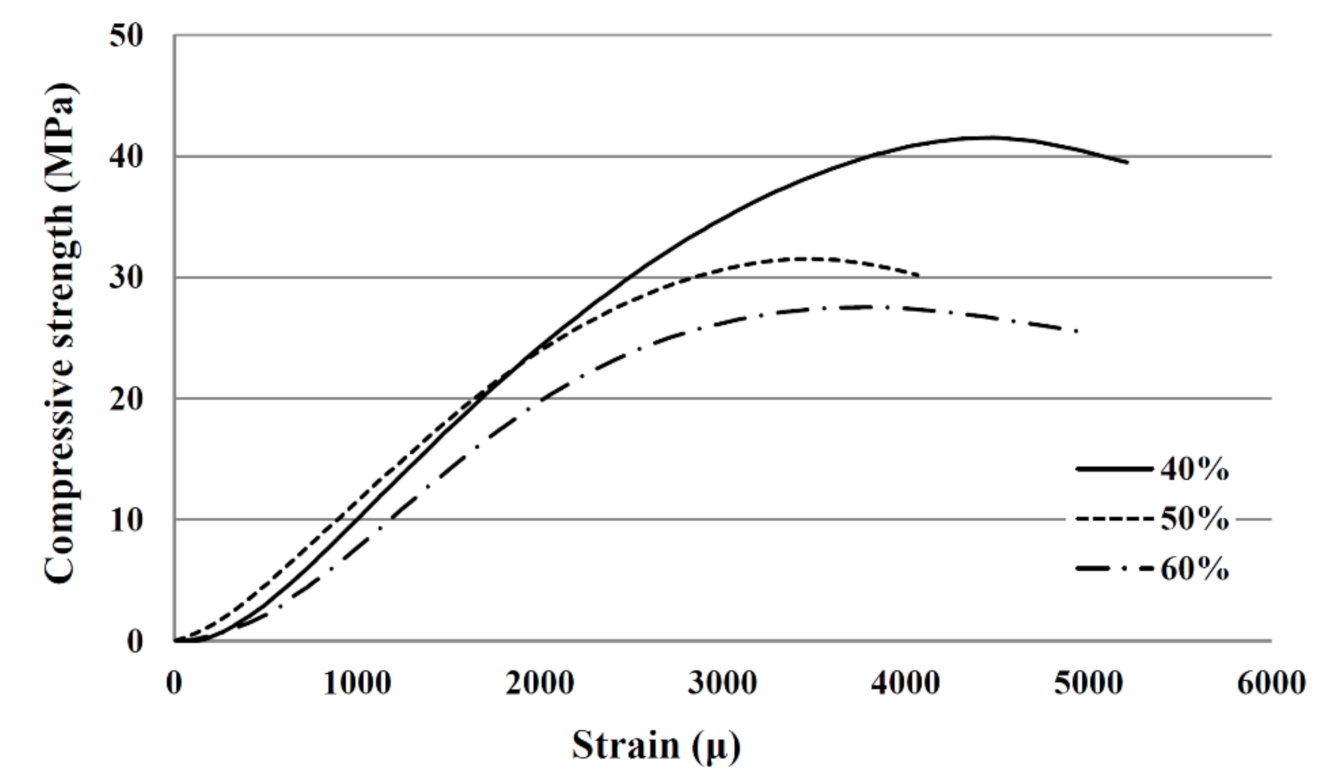

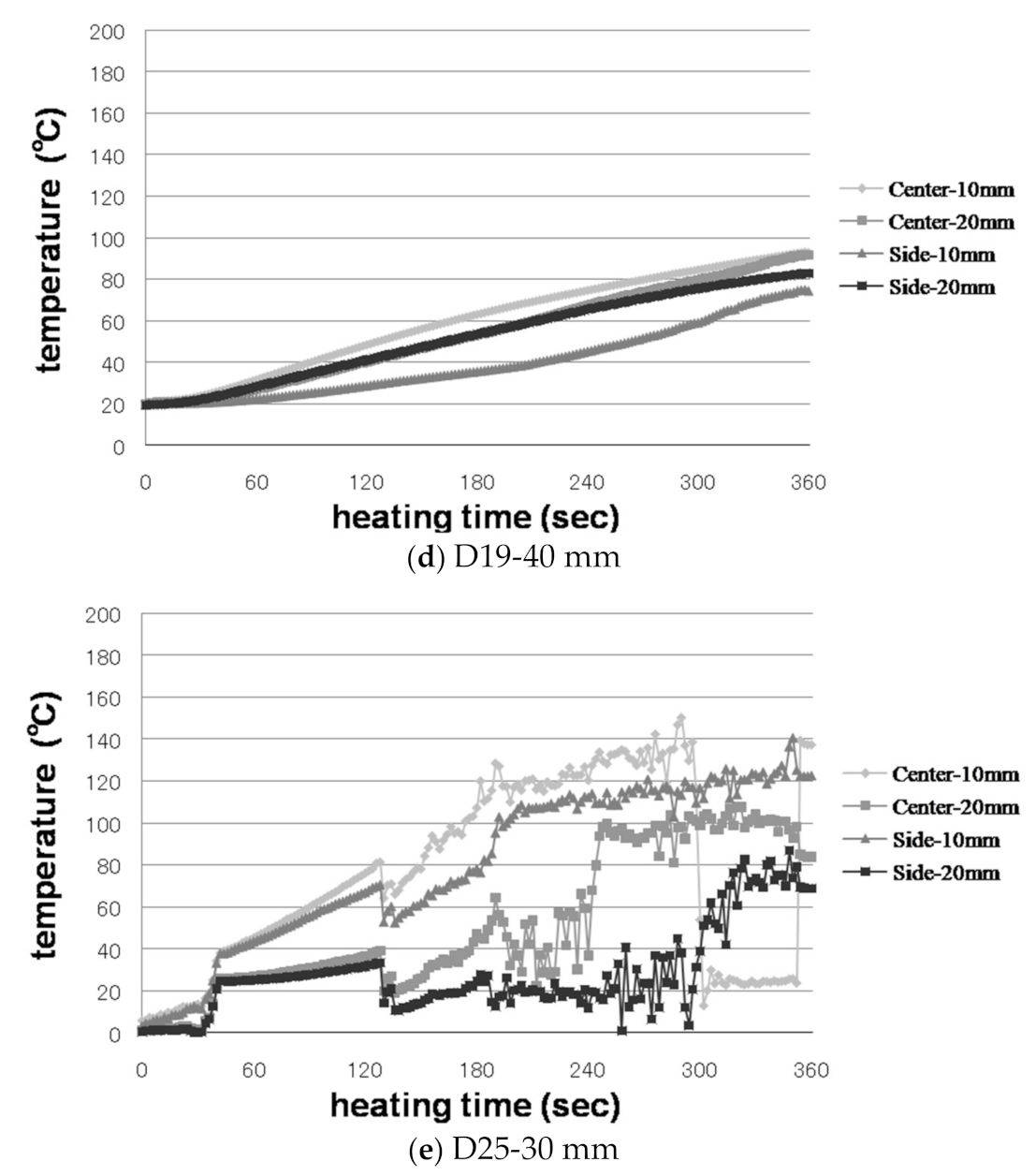
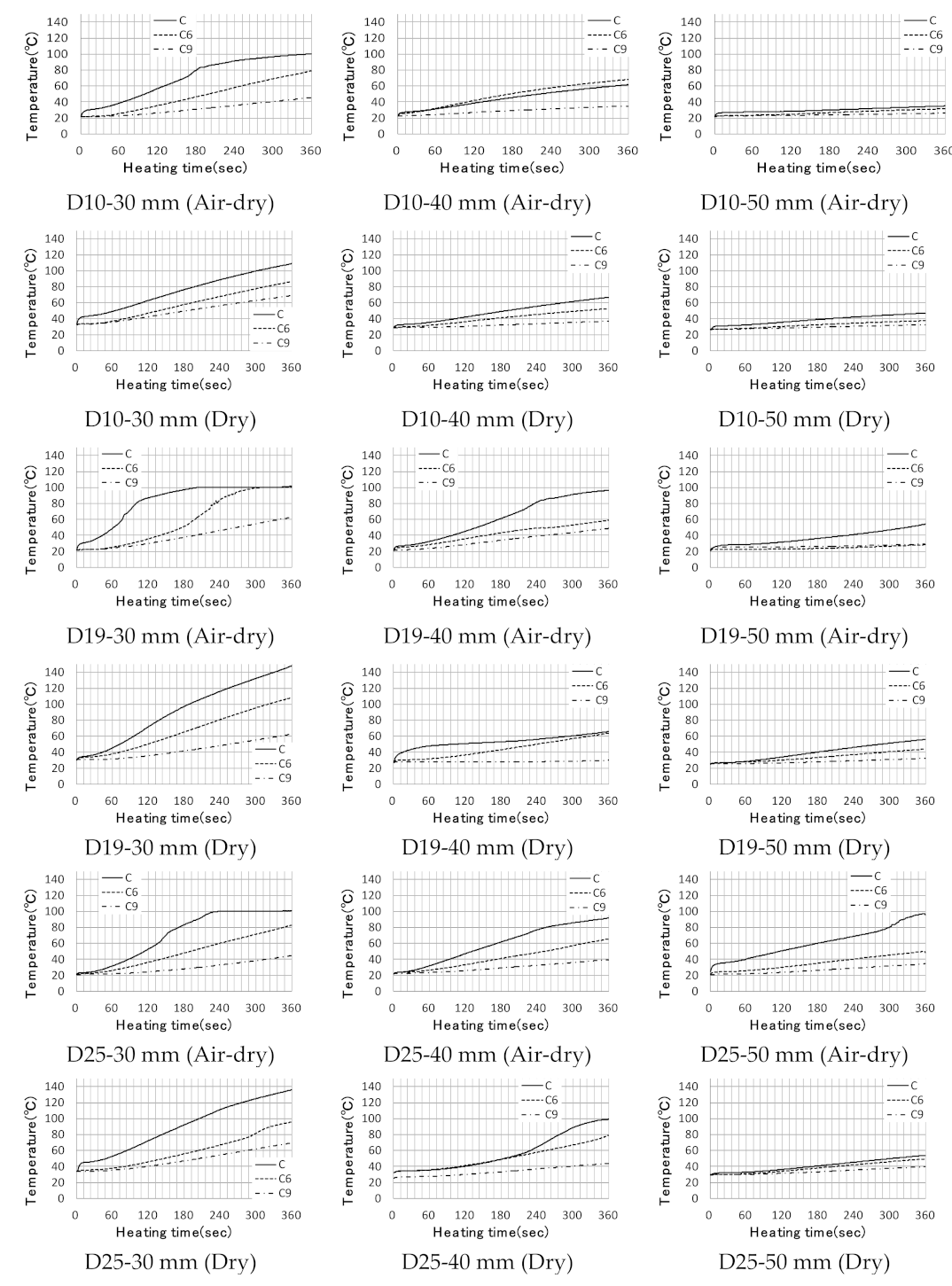
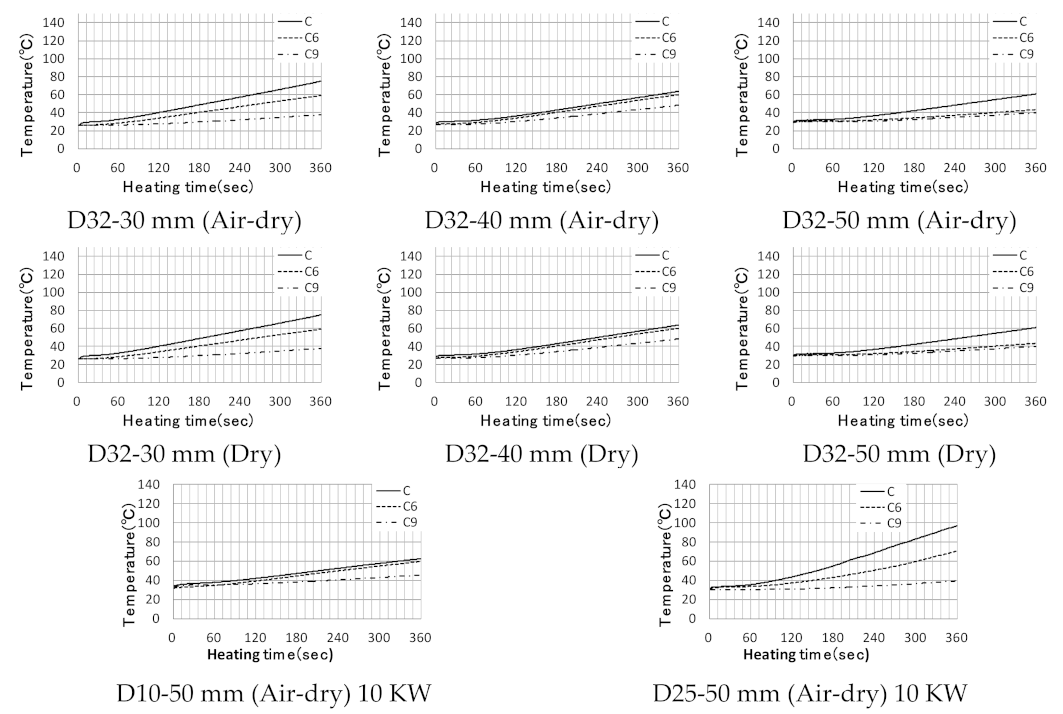
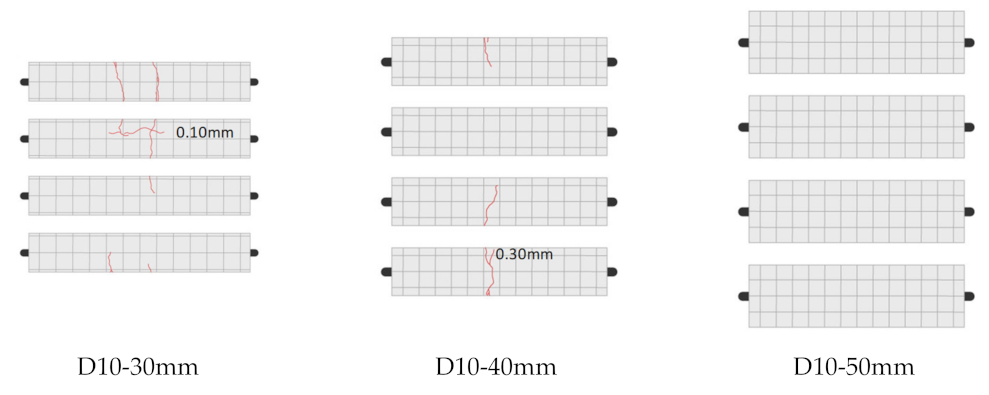
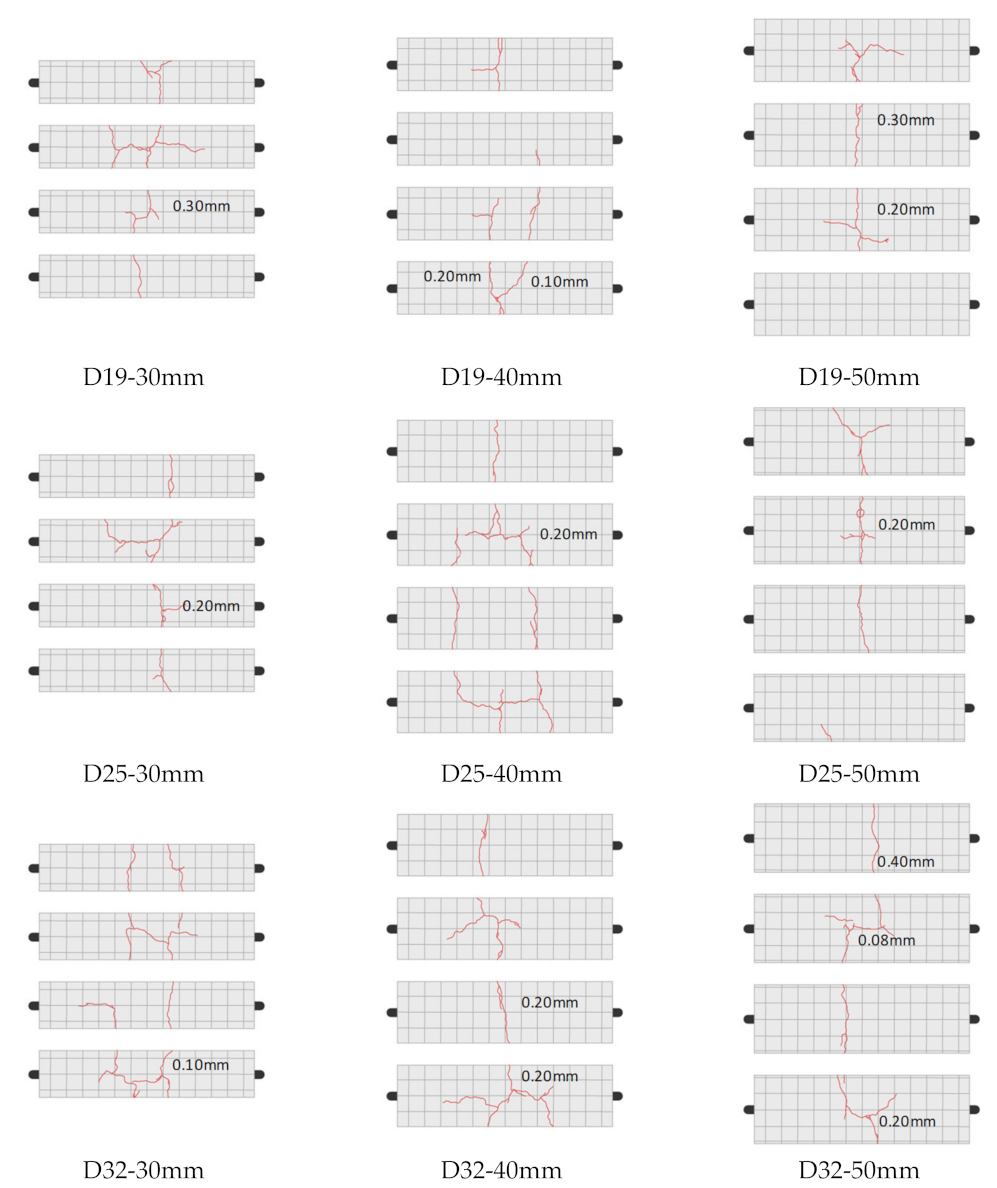



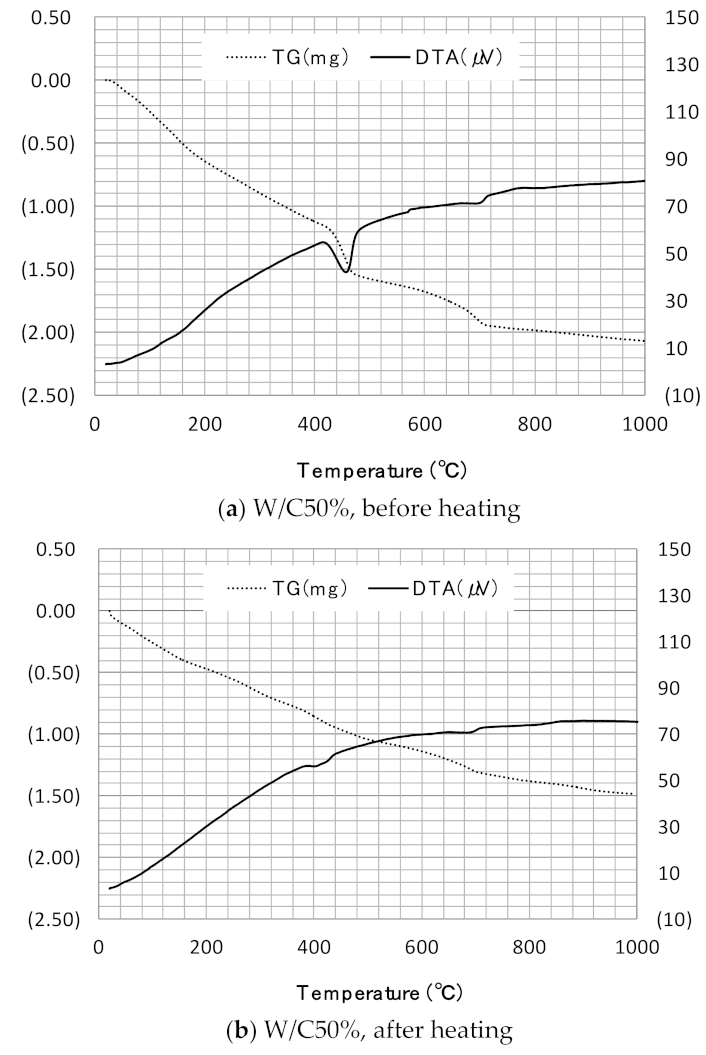

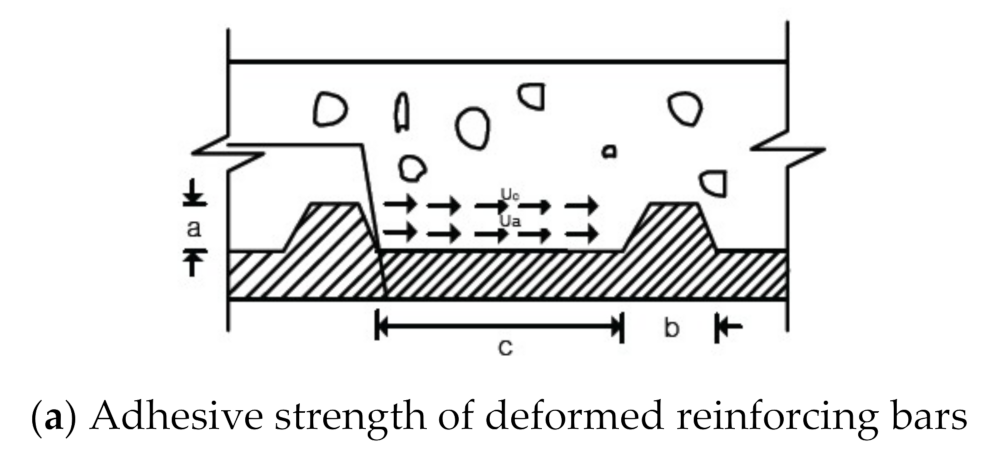


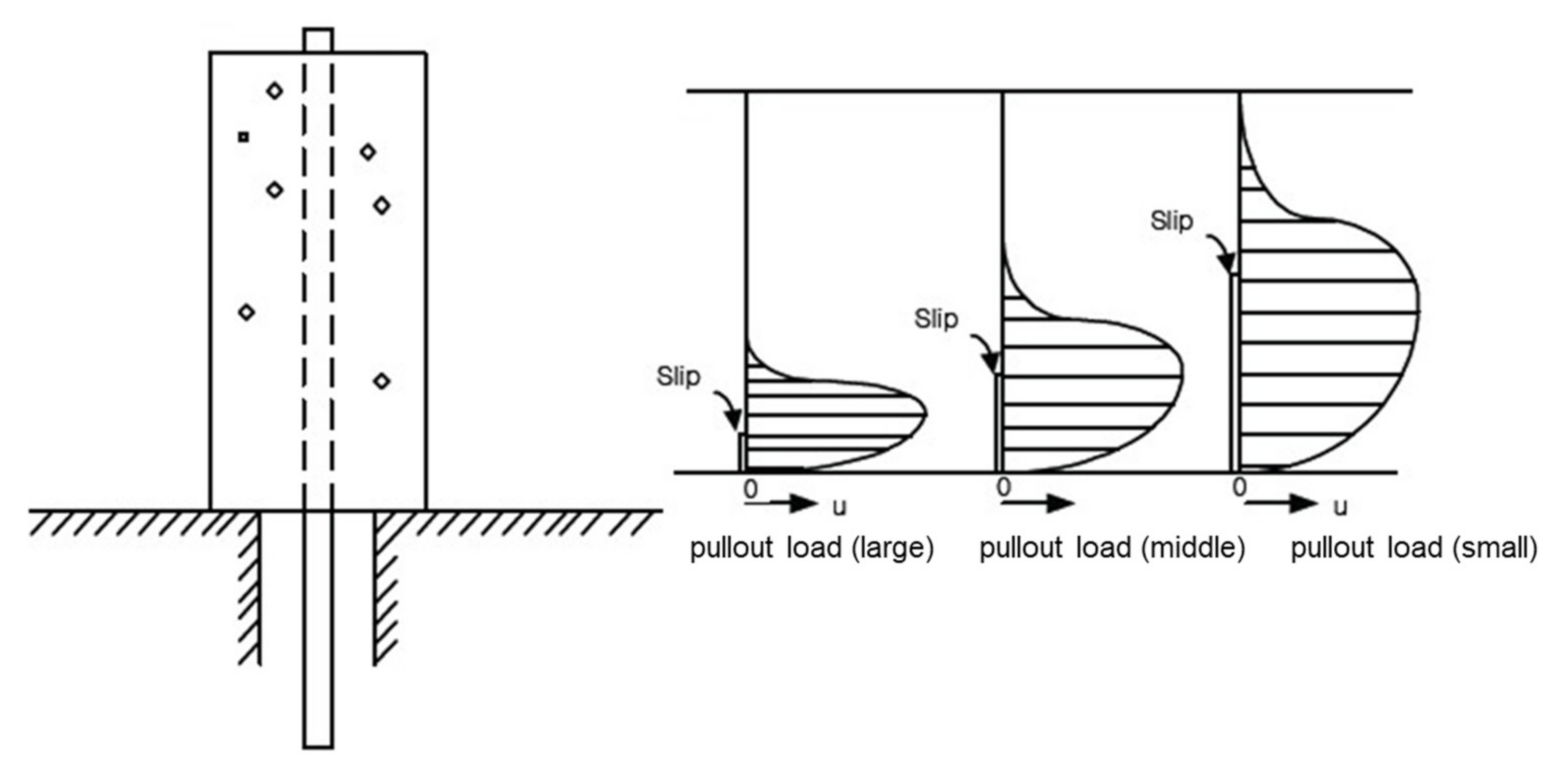
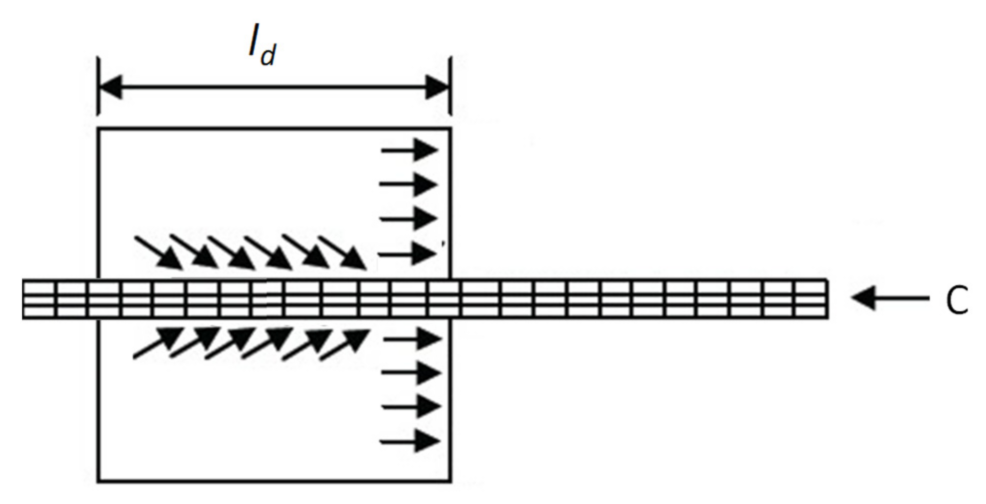
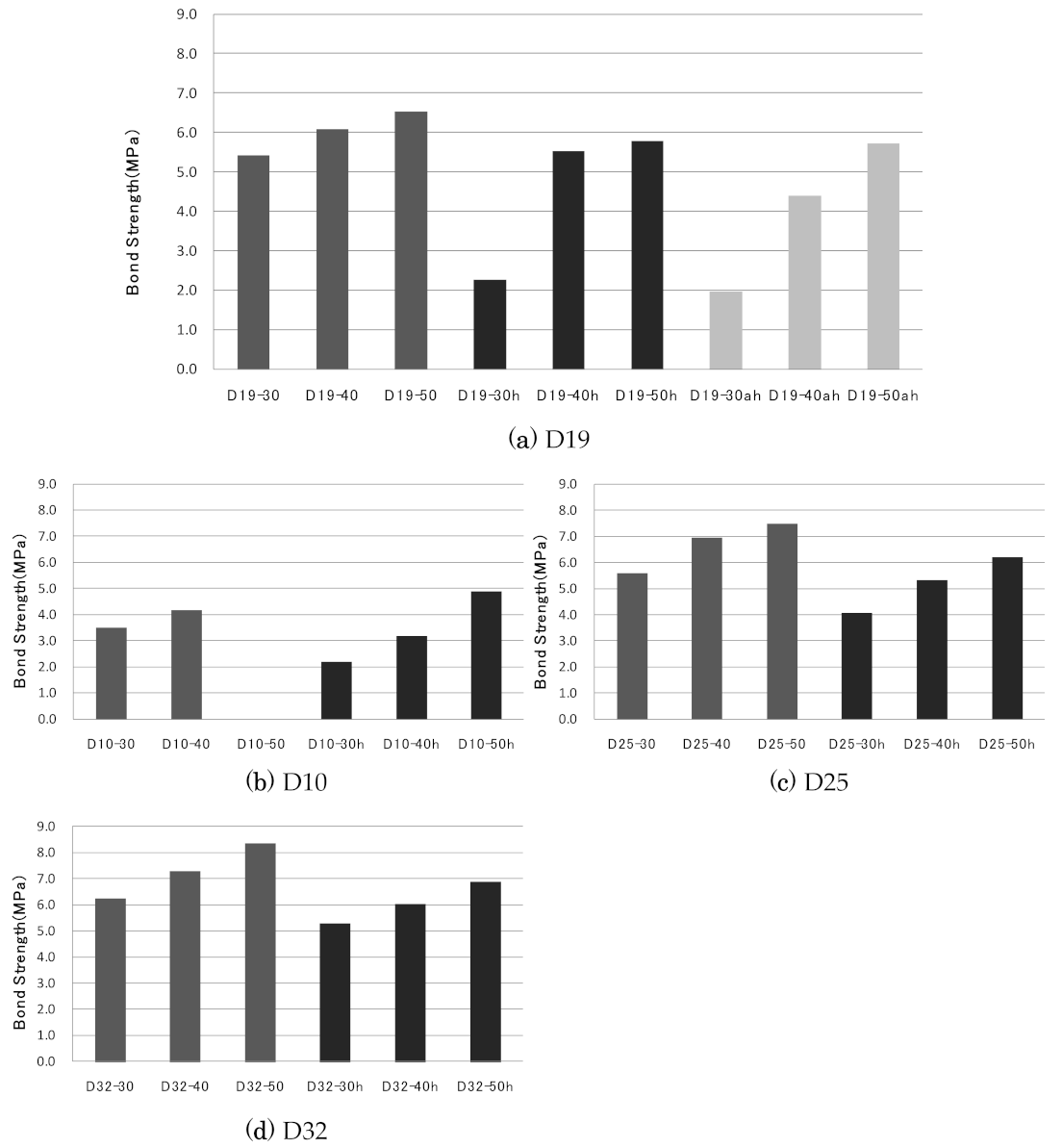



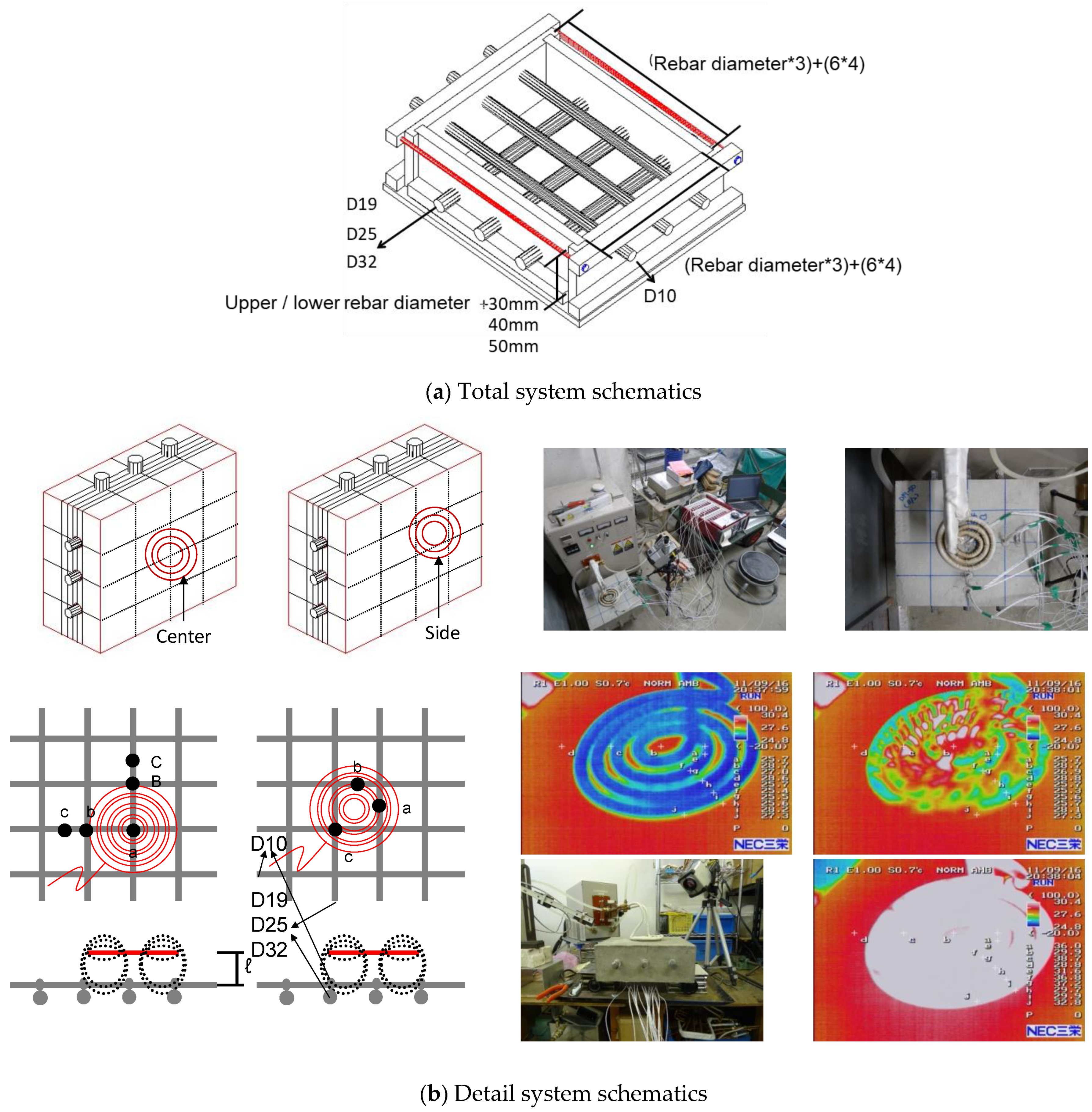

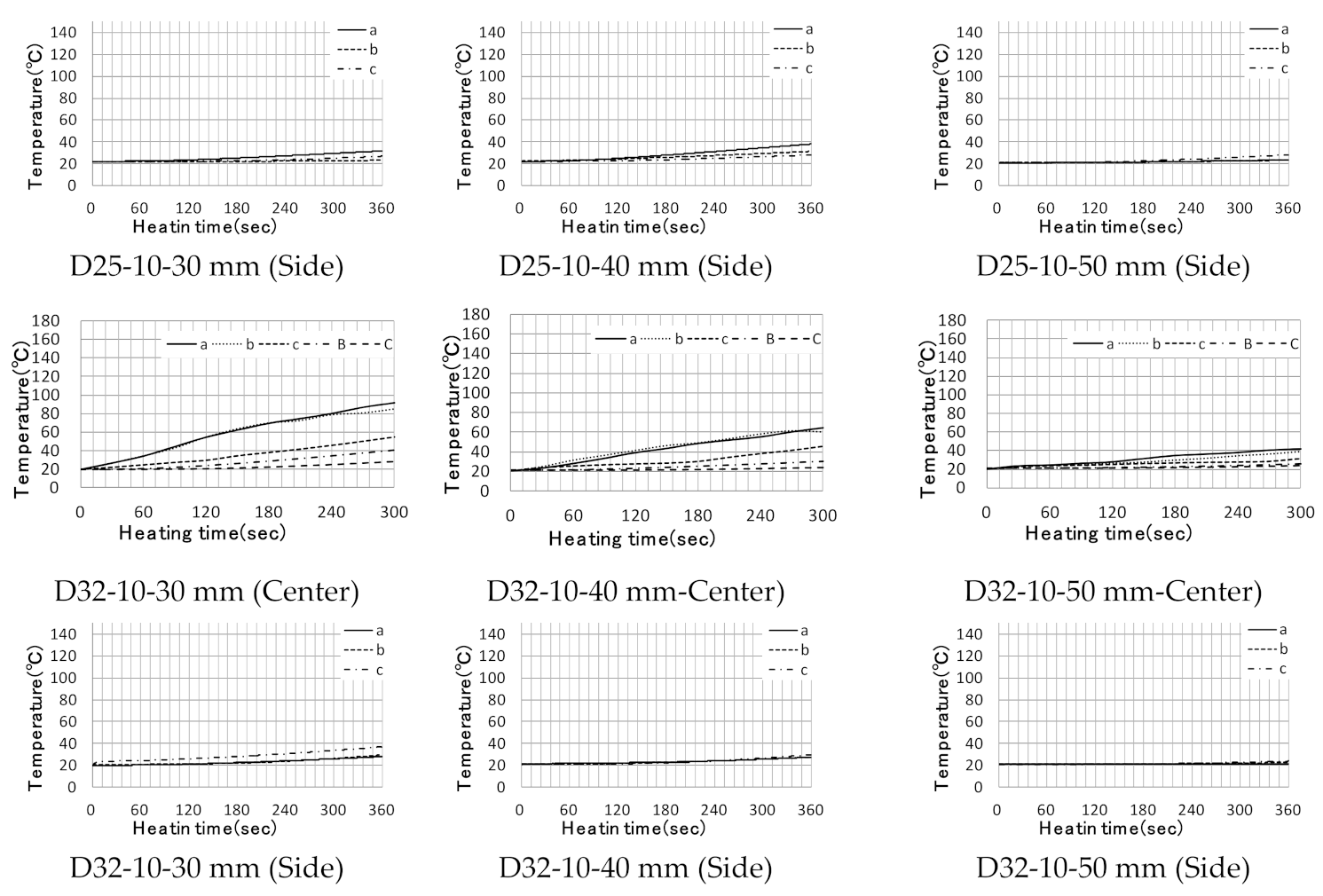

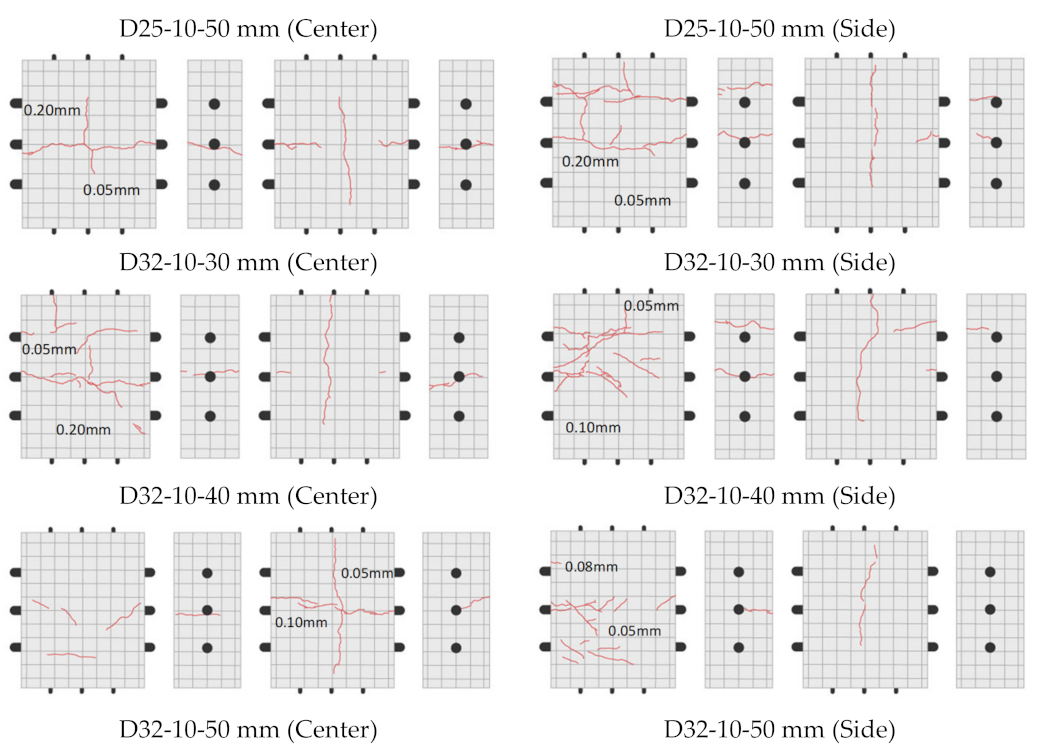

| Type | Power (KW) | Length of Reinforcement (mm) | W/C (%) | Heating Distance (mm) | |||||||
|---|---|---|---|---|---|---|---|---|---|---|---|
| D10 | 5 | 10 | 170 | 430 | 40 | 50 | 60 | 20 | 30 | 40 | 50 |
| D19 | |||||||||||
| D25 | |||||||||||
| D32 | |||||||||||
| Specifications | Physical Properties | |
|---|---|---|
| cement | Portland cement | Density: 3.16 [g/cm3], specific surface area: 3330 [cm2/g] |
| fine aggregate | Aquatic Land Sand (S) | Front dry density: 2.60 [g/cm3], FM: 2.55 |
| coarse aggregate | Ome Crushed Stone 20~5 mm | Front dry density: 2.66 [g/cm3], FM: 5 |
| chemical blending material | AE water reducing agent | Polycarboxylic acid series |
| Slump (cm) | Air (%) | W/C (%) | Gmax (mm) | S/a (%) | W (Kg/m3) | Weight Preparation (Kg/m3) | Admixture | ||
|---|---|---|---|---|---|---|---|---|---|
| C | S | G | |||||||
| 13.4 | 2 | 40 | 25 | 42 | 180 | 450 | 707.2 | 999.1 | C (0.3%) |
| 13.1 | 1.9 | 50 | 25 | 45 | 180 | 360 | 799.1 | 1003.44 | |
| 13.4 | 1.6 | 60 | 25 | 47 | 180 | 300 | 849.36 | 979.92 | |
| Temperature (°C) | Expansion Rate (dL/L) (%) | Coefficient of Expansion (a) × 10−5 |
|---|---|---|
| 100.0 | 0.0611 | 1.0181 |
| 200.0 | 0.1817 | 1.1358 |
| 300.0 | 0.3223 | 1.2398 |
| 400.0 | 0.1746 | 1.3185 |
| 500.0 | 0.6407 | 1.3929 |
| 600.0 | 0.8044 | 1.4365 |
| 700.0 | 0.9825 | 1.4888 |
| 800.0 | 1.0670 | 1.4039 |
| Temperature Interval | Decomposing Substance |
|---|---|
| 110 | Physically contained water Etringite (3CaO·Al2O3·3CaSO4·32H2O) |
| 110–300 | Calcium silicate (3CaO/2SiO2,3H2O) |
| 290–350 | Calcium aluminate silicate, calcium aluminate (Ca2Al(OH)7.3H2O, or 4CaO·Al2O3·13H2O), calcium chloroaluminate (3CaO·Al2O3·CaCl2·10H2O) |
| 400–510 | Calcium hydroxide (Ca(OH)2) |
| 700–750 | Calcium carbonate (CaCO3) |
| Type | a/c | Calculated Value |
|---|---|---|
| D10 | 0.6/6.7 | 0.0896 |
| D19 | 1.5/13.4 | 0.112 |
| D25 | 1.95/17.8 | 0.1096 |
| D32 | 2.4/22.3 | 0.1076 |
| Type | Crushing Load (kN) | Total Area of Reinforcement Attachment (mm2) | Crushing Strength (MPa) |
|---|---|---|---|
| D10-30 mm-normal | 41.16 | 11,743.60 | 3.5 |
| D10-40 mm-normal | 49.00 | 11,743.60 | 4.17 |
| D10-50 mm-normal | - | 11,743.60 | - |
| D10-30 mm-heating | 26.01 | 11,743.60 | 2.20 |
| D10-40 mm-heating | 37.03 | 11,743.60 | 3.18 |
| D10-50 mm-heating | 57.11 | 11,743.60 | 4.88 |
| D19-30 mm-normal | 130.04 | 23,989.60 | 5.42 |
| D19-40 mm-normal | 145.71 | 23,989.60 | 6.07 |
| D19-50 mm-normal | 156.84 | 23,989.60 | 6.54 |
| D19-30 mm-heating | 54.22 | 23,989.60 | 2.26 |
| D19-40 mm-heating | 132.62 | 23,989.60 | 5.53 |
| D19-50 mm-heating | 137.79 | 23,989.60 | 5.79 |
| D19-30 mm-heating (All heating) | 47.04 | 23,989.60 | 1.96 |
| D19-40 mm-heating (All heating) | 105.18 | 23,989.60 | 4.38 |
| D19-50 mm-heating (All heating) | 137.80 | 23,989.60 | 5.72 |
| D25-30 mm-normal | 180.12 | 31,902.40 | 5.60 |
| D25-40 mm-normal | 220.22 | 31,902.40 | 6.94 |
| D25-50 mm-normal | 230.13 | 31,902.40 | 7.49 |
| D25-30 mm-heating | 130.08 | 31,902.40 | 4.07 |
| D25-40 mm-heating | 168.93 | 31,902.40 | 5.33 |
| D25-50 mm-heating | 198.61 | 31,902.40 | 6.19 |
| D32-30 mm-normal | 247.71 | 39,940.80 | 6.25 |
| D32-40 mm-normal | 290.13 | 39,940.80 | 7.28 |
| D32-50 mm-normal | 333.84 | 39,940.80 | 8.36 |
| D32-30 mm-heating | 212.83 | 39,940.80 | 5.29 |
| D32-40 mm-heating | 243.14 | 39,940.80 | 6.04 |
| D32-50 mm-heating | 273.25 | 39,940.80 | 6.88 |
| Type | Distance | Length of Reinforcement | W/C | Power | Heating Position |
|---|---|---|---|---|---|
| D10-40% | 30 mm | 130 mm | 40% | 5 KW | Total heating |
| D10-50% | 50% | ||||
| D10-60% | 60% |
| Type | Distance | Length of Reinforcement | W/C | Power | Heating Location |
|---|---|---|---|---|---|
| D19-10 | 30 mm | 355 mm | 50% | 5 kW 10 kW | Center Side |
| D25-10 | 40 mm | ||||
| D32-10 | 50 mm |
| Name and Type | Physical Properties | |
|---|---|---|
| Cement | Portland cement | Density: 3.16 [g/cm3], Specific surface area: 3330 [cm2/g] |
| Fine aggregate | Oigawa Water System Land Sand (S) | Surface dry density: 2.60 [g/cm3], FM: 2.55 |
| Coarse aggregate | Ome Crushed Stones 20–5 mm | Surface dry density: 2.66 [g/cm3] |
| Chemical admixture | AE water reducing agent | polycarboxylic acid series |
| Slump (cm) | Air (%) | W/C (%) | Gmax (mm) | S/a (%) | Wunit (Kg/m3) | Weight Preparation (Kg/m3) | Admixture | ||
|---|---|---|---|---|---|---|---|---|---|
| C | S | G | |||||||
| 13.1 | 1.9 | 50 | 25 | 45 | 180 | 360 | 799.1 | 1003.44 | C (0.3%) |
Publisher’s Note: MDPI stays neutral with regard to jurisdictional claims in published maps and institutional affiliations. |
© 2021 by the authors. Licensee MDPI, Basel, Switzerland. This article is an open access article distributed under the terms and conditions of the Creative Commons Attribution (CC BY) license (https://creativecommons.org/licenses/by/4.0/).
Share and Cite
Lim, M.-k.; Lee, C. Evaluation of Weakening Characteristics of Reinforced Concrete Using High-Frequency Induction Heating Method. Appl. Sci. 2021, 11, 5402. https://doi.org/10.3390/app11125402
Lim M-k, Lee C. Evaluation of Weakening Characteristics of Reinforced Concrete Using High-Frequency Induction Heating Method. Applied Sciences. 2021; 11(12):5402. https://doi.org/10.3390/app11125402
Chicago/Turabian StyleLim, Myung-kwan, and Changhee Lee. 2021. "Evaluation of Weakening Characteristics of Reinforced Concrete Using High-Frequency Induction Heating Method" Applied Sciences 11, no. 12: 5402. https://doi.org/10.3390/app11125402






